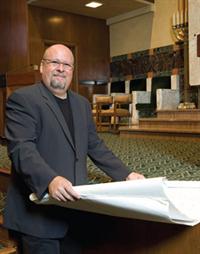

Sound Counsel
Built in the 4th century B.C., the theater at Epidaurus in Greece remains a marvel of acoustical engineering. With a seating capacity of 14,000, the ancient performance venue uncannily delivers unamplified sound to the outermost row that’s almost as audible as that which is heard by listeners near the stage.
BUILT IN THE 4TH CENTURY B.C., the theater at Epidaurus in Greece remains a marvel of acoustical engineering. With a seating capacity of 14,000, the ancient performance venue uncannily delivers unamplified sound to the outermost row that’s almost as audible as that which is heard by listeners near the stage.UNHAPPY CO-EXISTENCEThese days, the vast majority of architecture students receive only enough exposure to acoustics to know that it’s important and that they need a consultant to address the subject (see “Tomorrow’s Acousticians Today?” below).
SIA Acoustics’ Sam Berkow at Temple Israel of Hollywood in Los Angeles.
Researchers at the Georgia Institute of Technology, reporting in the in April 2007 issue of Journal of the Acoustics Society, uncovered some of the theater’s acoustical secrets. Most notably, the corrugated, limestone seats suppress the low-pitched frequencies of mumbling audience members, thereby limiting background chatter. Meanwhile, the limestone reflects and enhances the higher frequencies of the performance.
Interestingly, the architect who designed this extraordinary venue, Polykleitos the Younger, seemed simply to stumble onto these phenomena, based on his subsequent unsuccessful attempts to duplicate his acoustical acumen in other theaters using alternative seating materials, such as wood.
If he were alive and working today, Polykleitos would have a specially trained acoustical consultant to help him figure out what he did right the first time. If the sound still weren’t right, he might kick the problem off to an audio systems integrator, hoping some magical DSP-based solution would do the trick. But would Polykleitos himself have a greater understanding—and interest—in building acoustics? That’s questionable.
The fact is, architects need acoustics experts. Fostering a relationship between the two is key to successful AV projects—and a source of ongoing business opportunities.
“Acoustics is not a new science,” says Dr. Ning Xiang, an associate professor specializing in architectural acoustics at the Rensselaer Polytechnic Institute in Troy, N.Y. “Unfortunately, architecture schools don’t tend to pay a lot of attention to it.”
To better communicate with the architects it works with, SIA Acoustics creates its own renderings. Left is a typical detail for a double wall and an acoustically isolated space under the suspended ceiling. The rendering on the right shows isolated room construction with isolated walls, ceiling, and floor where an existing wall and ceiling slab are in already place.
That’s not to say that architecture schools don’t offer training in acoustics. Like a number of other institutions, Rensselaer, for instance, offers an intense graduate curriculum in building acoustics. Xiang says that more than 90 percent of the students who successfully complete the course load immediately find jobs in acoustic consulting. “That proves our society needs this profession,” he says.
Indeed, the acoustical consultancy profession is a burgeoning one, according to noted sound expert Sam Berkow, founder of New York–based SIA Acoustics. “Audiences in churches, sports venues, auditoriums, and theaters expect more now. They want quality sound,” he explains.
Still, the evolution of acoustician as a specialized profession within the architectural trade has resulted in an oft-unhappy co-existence: Call it “acoustical consultants and the architects who know they need them, but don’t always love them.”
“Architects recognize they need to address acoustics in the design phase, but there are many who don’t necessarily like working with acoustical consultants,” says Berkow. “They don’t want to be constrained in their vision and their sense of form and function.”
Speaking what he calls “the language of the architect,” Berkow and his team detail their acoustical design concepts with their own architectural renderings, and often involve themselves on site during the entire construction of a building.
“We spend a lot of time on construction sites making sure things are built right,” he says.
Often, he explains, buildings will be designed with acoustic isolation problems, meaning sound leaks excessively from room to room. “The architect will say, ‘Fine, we’ll add an extra layer of wallboard, and we’ll make the wall thicker and heavier.’ But they won’t address the fact they have all this pipe work and conduit running through the wall, creating all of these penetrations.”
While Berkow has encountered plenty of builders who embrace working with him during design and construction, in order to avoid problems later, there are others who are reluctant. “Instead of approaching acoustics as a design challenge, they say, ‘We’re going to do this anyway, and you’re going to make it work.’”
“Historically, architects design a room then hire a consultant to come in and do the acoustics,” Berkow adds. “That philosophy has proven ineffective in places like concert halls, music studios, and places of worship. You don’t design a room then do the acoustics. You design a room with proper acoustics.”
Sound Counsel
Built in the 4th century B.C., the theater at Epidaurus in Greece remains a marvel of acoustical engineering. With a seating capacity of 14,000, the ancient performance venue uncannily delivers unamplified sound to the outermost row that’s almost as audible as that which is heard by listeners near the stage.
TECHNOLOGY AS A CRUTCH
The burden of architect’s “fix it in the mix” mentality, the idea that any acoustical deficiencies can be addressed after the building goes up, often extends to AV integrators.
“Acoustical consultants are brought in for large projects like concert halls, but on smaller projects, it’s often the sound system contractor who needs to take care of acoustical problems,” says Brad Nelson, owner of Kennewick, Wash.–based Sound Solutions Northwest, a company that specializes in the house of worship sector. “And often the mindset is that the sound system itself will fix things. That’s where we get into a lot of problems.”
Nelson and others believe architects’ disregard for acoustics can be blamed, at least in part, on advances in audio electronics—not to mention modern building materials and techniques.
“With the advent of modern sound systems, acoustical considerations have really gone by the wayside,” says Bill Schafer, an engineer who has overseen a number of loudspeaker installations at Los Angeles International Airport for Hawthorne, Calif.–based Direct AV. “If you look at churches that were built 100 years ago, there was no sound system, and the building had to be designed so that voice audio could project unaided throughout the facility. These older buildings tend to be a little more diffuse in terms of their reverberation—you don’t find a lot of flutter echo or hard slap. You tend to find a lot of columns or other detail in the room that breaks up sound. There’s also a lot of wood in these places, which is a lot better [for sound quality] than drywall.”
For his part, Nelson concedes that ornate wooden structures may not be practical construction considerations anymore. “It’s certainly a lot cheaper and easier to work with Gypsum wallboard and large, flat surfaces,” he notes. “That’s kind of the default way of building these days, and from a construction and appearance standpoint, that’s fine. But from an acoustic standpoint, that can create challenges in certain situations. We often find ourselves having to look for some creative solution to put a Band-aid on things.”
TOMORROW’S ACOUSTICIANS TODAY?
At Cornell University, students in the top-rated Professional Master of Architecture program learn about acoustics in their fourth term when they get to “Arch 662–Environmental Systems 2: Lighting and Acoustics.” Meanwhile, within the University of Nebraska Architectural Engineering program, education in acoustics is a bit more detailed, including a class called “AREN 833: Advanced Architectural Acoustics.” The objectives for this course include:
Understanding the behavior of sound in rooms
Making objective measurements of room qualities
Designing spaces with specific acoustical needs
Applying physical and computational models during the design process, recognizing both their utility and limitations
These courses teach acoustics on a “fundamental level,” says Dr. Ning Xiang, associate professor specializing in architectural acoustics at the Rensselaer Polytechnic Institute in Troy, N.Y. Xiang claims the science of acoustics is far too broad to be effectively mastered within the context of a one-semester, three-unit course.
At Rensselaer, Xiang directs an architectural acoustics graduate program that “offers an intense curriculum in acoustics for effectively shaping sonic environments to achieve optimum acoustic performance and sound quality.” He believes architecture schools will increasingly cede the area of building acoustics to intense, specialized curriculums, whether they be interdisciplinary programs or housed within the departments of architecture themselves. And building designers will become increasingly dependent on these professionals.
Within modern buildings, flutter echo—the repetitive reflection of sound waves caused by hard, flat parallel walls or floors and ceilings—is a common problem. In many cases, this issue can be effectively addressed after the fact with the strategic placement of sound-absorbing materials, such as foam or ceiling tiles.
Meanwhile, recent technological advances—such as digital signal processing, which enable loud speakers to precisely direct sound waves to places where they don’t bounce around—have created other options for integrators who need to address problem audio environments.
“But there’s no amount of DSP that’s going to alleviate things like high reverberation time or flutter echo between parallel walls,” Nelson notes. “Unfortunately, once the sound leaves the loudspeaker, the room acoustics take control.”
If architects aren’t aware of acoustics, and just what modern AV technology can and can’t do to enhance them, they can be forgiven, says Keith Willis, co-owner of Innovative Theaters, an integrator of high-end residential AV systems, based in West Hollywood, Calif.
Acoustics is an involved science, Willis says, and architects are now designing buildings that often employ state-of-the art electronic audio enhancement—technology that is often too specialized for them to fully understand.
“You have to be well versed in the products to understand acoustics,” Willis says, noting that many of Innovative Theaters’ projects are new homes in which he and his business partner work closely with the architect.
“And there is no global rule of thumb to acoustic design—it’s a lot of trial and error, and also an understanding of what the sound system is capable of. Our industry has grown so fast, there’s no way for an architect to have a finger on the pulse of all this stuff. They shouldn’t have to know this stuff. But at the same time, architects must recognize that acoustics [isn’t] their area of expertise,” Willis explains. And seek expert help.
Daniel Frankel is a freelance writer based in Los Angeles. He can be reached at [email protected].










